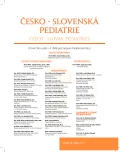-
Medical journals
- Career
Approach to children with first, uncomplicated upper urinary tract infection
Authors: L. Kovács; V. Jankó
Authors‘ workplace: Bratislava ; Detská klinika Lekárskej fakulty Univerzity Komenského a Detskej fakultnej nemocnice s poliklinikou
Published in: Čes-slov Pediat 2017; 72 (1): 8-10.
Category:
Overview
Upper urinary tract infection (UTI) is one of the most common bacterial infections in infants and children. Its early diagnosis is important as it may be a marker for urinary tract abnormalities. Most cases of uncomplicated upper UTI respond readily to antibiotic treatment without further sequelae. In recent years there is a developing consensus regarding the need for a less aggressive therapeutic approach with sequential (initially intravenous followed by oral) antibiotics, less invasive investigations, cystourethrography in particular, and without long-term antibacterial prophylaxis following an uncomplicated first febrile upper UTI in infants and children.
The proposed algorithmic approach is aimed to ensure rapid diagnosis and correct management of this particular form of UTI.Key words:
urinary tract infection, pyelonephritis, diagnosis, treatment, algorithm
Sources
1. Ammenti A, Cataldi L, Chimenz R, et al. Febrile urinary tract infections in young children: recommendations for the diagnosis, treatment and follow-up. Acta Paediatr 2012; 101 : 451–457.
2. Garcia CM. Guideline development group of the CPG for urinary tract infection in children. Clinical practice guideline for urinary tract infection in children. http://www.guiasalud.es/GPC/GPC_483_ITU_poblacion_pediatrica_ICS_ing.pdf 2011.
3. Roberts KB, and Subcommittee on Urinary Tract Infection. Urinary tract infection: clinical practice guideline for the diagnosis and management of the initial UTI in febrile infants and children 2 to 24 months. Pediatrics 2011; 128 : 595–610.
4. Royal Children‘s Hospital Melbourne. Clinical practice guidelines. www.rch.org.au/clinicalguide/cpgcfm?doc_id=5241 2013.
5. Rudin C, Laube G, Berger C. Diagnose und Behandlung von Harnwegsinfektionen beim Kind. Paediatrica 2013; 24 : 10–13.
6. Welsh A, and National Collaborating Centre for Women’s and Children’s Health (NICE). Urinary tract infection in children: diagnosis, treatment and long-term management. 2007. Available from: www.nice.org.uk/nicemedia/pdf/GG54fullguideline.pdf.
7. Seeman T, Bláhová K, Bébrová E, Kynčl M, Janda J. Doporučení pro diagnostiku a léčbu infekcí močových cest u dětí Pracovní skupiny dětské nefrologie České pediatrické společnosti. Čes-slov Pediat 2017; v tlači.
8. Hadjipanayis A, Grossman Z, Del Torso S, et al. Current primary care management of children aged 1-36 months with urinary tract infections in Europe: large scale survey of paediatric practice. Arch Dis Child 2015; 100 : 341–317.
9. Jankó V, Kovács L. Včasná antibiotická terapia a riziko renálneho jazvenia u detí s prvou nekomplikovanou infekciou močových ciest. Čes-slov Pediat 2017; 72 (1): 15–19.
10. Flögelová H, Stašková L, Michálková K. Recidivující infekce močových cest – přínos diagnostiky a léčby dysfunkční mikce. Čes-slov Pediat 2017; 72 (1): 11–14.
11. Zieg J. Vezikoureterální reflux u dětí: stále mnoho nezodpovězených otázek. Čas Lék čes 2016; 155 : 31–34.
Labels
Neonatology Paediatrics General practitioner for children and adolescents
Article was published inCzech-Slovak Pediatrics

2017 Issue 1-
All articles in this issue
- Approach to children with first, uncomplicated upper urinary tract infection
- Recurrent urinary tract infection – benefit of the diagnosis and treatment of voiding dysfunction
- Early antibiotic therapy and risk of renal scarring in children with a first uncomplicated urinary tract infection
- Haemophilus diseases in ENT in children before and after the introduction of Haemophilus influenzae type b vaccine
- Unusual case of hypercalcemia in a patient with primary steroid-resistant nephrotic syndrome
- Quality of sleep in children and adolescents with type 1 diabetes
- Thyroid function in obese children
- Repeated gastrointestinal bleeding
- General Movements – examination of immature nervous system
- Acquired cardiovascular disease in Turner syndrome
- Guideline for the Neurodiagnostic Evaluation of the Child With a Simple Febrile Seizure. Adapted Clinical Practice Guideline of the American Academy of Pediatrics
- Czech-Slovak Pediatrics
- Journal archive
- Current issue
- Online only
- About the journal
Most read in this issue- Haemophilus diseases in ENT in children before and after the introduction of Haemophilus influenzae type b vaccine
- Repeated gastrointestinal bleeding
- General Movements – examination of immature nervous system
- Guideline for the Neurodiagnostic Evaluation of the Child With a Simple Febrile Seizure. Adapted Clinical Practice Guideline of the American Academy of Pediatrics
Login#ADS_BOTTOM_SCRIPTS#Forgotten passwordEnter the email address that you registered with. We will send you instructions on how to set a new password.
- Career

